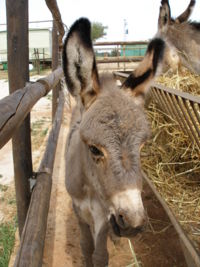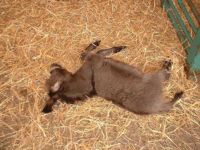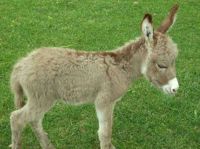Orphans - Donkey
| This article has been peer reviewed but is awaiting expert review. If you would like to help with this, please see more information about expert reviewing. |
Introduction
A foal may be orphaned because of its mother’s death, rejected due to antagonistic behaviour or undernourished because of an inadequate milk supply. Alternative means of maintenance must be found until it is at least five months old.
Fostering
Finding a nurse mare has many advantages, but they are rarely available. A mare that has just lost her foal is ideal. Success depends on a number of variables affecting the mare-to-foal relationship, including:
- Mares that have had a stillborn foal or have not been suckled are less likely to accept another foal
- The longer the period between the death of the mare’s foal and the introduction of the orphan foal, the less the chance of success. After two to three days of not being suckled the mare’s milk may dry up
- If the size discrepancy between mare and foal is great, the chance of acceptance is less
- If the foal has never suckled, it gradually loses the instinct
- A mare’s mothering instinct varies between individuals. Some mares show extreme hostility at first but, once they have accepted a foal, they can make the best mothers
Overcoming rejection
There are a number of ways to help avoid or overcome rejection of a foster foal:
- Move the mare to an alternative stable from one she might associate with her dead foal
- The amnion, meconium or hide from a dead foal should be smeared over the orphan foal before presenting it to the mare
- Place a strong smell over the mare’s nostrils, e.g. ‘Vick’ vapour rub. Also place this on the foal, especially over hindquarters, head and neck. Renew at frequent intervals
- Put the foal to the mare when it is hungry, i.e. every three hours. Introduce the mare to the foal when she has a full udder
- Restraints such as chemical tranquillizers or hobbles can be used. The need to use restraints should diminish at each subsequent meeting
Observe the mare and foal when first left together. Some mares and foals are best kept separated by a partition. This will allow the sight and smell of each other, but will protect the foal.
If unsuccessful on the first encounter, re-introduce after a short period of time, as success may be achieved after further attempts. If the mare is still showing an antagonistic response after ten to twelve hours then the chances of success are poor.
Colostrum
Colostrum must be given within the first twelve hours of life; the first feed should be within two to four hours of birth. The recommended amount is 250 ml every hour for the first six hours, making a total of 1.5 litres.
In a case of rejection of the foal, obtaining the colostrum from the mother would be preferable, or it could be taken from another mare within two days of giving birth. A healthy mare should have enough for 250 ml to be taken off after her own foal has suckled. Clean hands and the mare’s udder before milking and sterilise all utensils.
Colostrum from a cow is not ideal, although if fed in large quantities it is better than none.
Collect colostrum and freeze at -15° to -20°C. Store in 250 ml batches. When required, defrost slowly in hot water until it reaches 38°C.
If the foal has received no colostrum, then plasma should be administered intravenously or by stomach tube during the first twelve hours of life.
Supplementary feeding
If a mare is not producing enough milk for her foal, her diet can be supplemented while she is in lactation. To try to increase milk production, the following methods may be successful:
- An injection of oxytocin to stimulate the milk flow
- Feed lucerne (alfalfa), or allow to graze on lush, green grass
Hand rearing
There may be no alternative but to hand rear. The following points should be considered:
- Personnel: Hand-rearing a foal is neither easy nor cheap, and those involved should be prepared to commit their time and resources. Experienced, conscientious personnel are essential.
- Companions: A foal can develop poor behavioural characteristics if hand-reared without other animal contact. Sheep and goats make good companions, but the foal should also be allowed to see other equines. When out in the fields (once the foal is over one month of age), it can be joined by a quiet pony or donkey. This companion will act as a role model.
- Exercise: Make sure that the foal gets regular exercise, especially as it gets older and stronger. As milk contains very little vitamin D, the foal should be allowed outside regularly in the sunlight. Donkeys exposed to sunlight for at least three hours a day can produce their own vitamin D, which is essential for proper bone development
- Environment: The foal should be kept in a warm, dry place, and sheltered from the wind. A clean loose box with clean bedding is ideal. The box should have been empty for two or three weeks before housing the foal and there should be no incidence of enteric disease associated with the area.
- Hygiene: The box and all equipment used should be cleaned, disinfected and/or sterilised. All personnel who enter the box should take the necessary hygiene precautions, particularly in the first 72 hours
Bottle feeding
This is time-consuming, but it is preferable to bucket feeding or intubation. It could be used in the transitional period before a foal is trained to drink from a bucket. Lambs’ teats are the closest in shape and pliancy to those of a donkey mare.
If the foal rejects the teat, place an index finger in its mouth and, if it does not suck, move the finger against the roof of the mouth. Slowly replace the index finger with the teat once sucking begins. Be patient. Keep the bottle in an upright position.
Bucket feeding
This is less time-consuming once the foal has been trained, but it is much harder to introduce than the bottle. It is usually best started when the foal is two weeks or older. Milk should be offered ad lib in a wide, shallow bucket placed at head height. It should be replenished twice daily, and the bucket cleaned thoroughly.
To train, place your fingers into the foal’s mouth and, as it begins to suck, slowly lower your hand into the bucket of milk. It may be necessary to push the foal’s head down to show it the bucket. It may take a whole day for a foal to learn to drink from a bucket.
Nasogastric intubation
Sometimes a weak foal needs to be fed via nasogastric tube. Insertion of the tube can be quite difficult, and great care must be taken during placement to ensure that the tube is in the oesophagus. Use the smallest diameter tube available, 10 or 12 French diameter and cap end to avoid aerophagia. This can be secured into place with elastoplast or similar, secured to a head collar.
Protocol for hand rearing
Warm milk to 38°C for initial feeds, gradually reducing to air temperature over the first week. Changes should always be made slowly over 24 to 48 hours.
A 10 kg foal requires 30 kcal/kg (125kJ/kg) per day. A sick or premature foal requires 36 kcal/kg (150kJ/kg) per day.
The recommended volume of milk for a healthy foal is 100 ml/kg body weight per day. For a 10 kg foal this means one litre of milk a day, i.e. 10% of its body weight.
A foal naturally sucks from its mother about seven times a day. Ideally it should be fed at two or three hourly intervals, although during the first week it is preferable to feed every one to two hours. If the foal is sick, it may be unable to tolerate more than 50 to 100 ml every hour, so more intensive rearing is required. As it improves this volume can gradually increase to 200 ml an hour.
Day 1 and 2: Feed 100 - 120 ml every two hours (10-15% of body weight) - ten to twelve feeds per day.
Day 3 to 7: Increase the volume of each feed to 150 - 200 ml (25% of body weight). Reduce the number of feeds to about eight a day, feeding every two or three hours. Milk-based pellets can be offered from one week old. When eating sufficiently, these should be substituted with a grain-based feed.
Weeks 2 and 3: Give 300 - 350 ml at each feed, and reduce to six feeds a day on a four-hourly basis. Allow access to fresh water and salt, and consider training to bucket feed. Supply good quality grains and a limited quantity of good quality hay to start the foal weaning. Creep feed of 18% protein is recommended.
Week 4: Feed 500 ml five times a day. Do not wean off milk until eating adequate dry food. The changeover should be gradual to allow the digestive enzymes to adapt.
Week 8 to 12: Weaning can be progressed during this time. Give one litre of feed, four times daily at eight weeks, then three feeds a day at twelve weeks. The foal may still be taking one to two litres of milk a day. A handreared foal should be fully weaned by five months of age.
Types of milk
Mare’s milk: This is obviously the best option for the foal, but is not always readily available. Milking a mare is very time-consuming.
Cow’s or goat’s milk: This is much easier to obtain but not similar in composition. It contains higher total solids, fat and protein but is considerably lower in sugars. The need to mix powders is avoided, but it can be expensive, particularly with regard to goat’s milk.
Cow’s milk can be made to resemble mare’s milk more closely by adding one teaspoon of honey to a pint of 2% fat milk. Jersey milk must not be used due to its high fat content. Goat’s milk seems very palatable. It is considered to be good foster milk as the fat particles are smaller than in cow’s milk and so it is more easily digested.
Cow’s milk may contain a surprising number of bacteria so it is advisable to pasteurise it by heating to 70°C for 15 seconds. The milk should then be cooled and dextrose can be added before feeding to the foal.
Suggested formula
- 300 ml cow’s milk
- 150 ml lime water (50g hydrated garden lime in 10 litres of water - leave overnight to settle, and then pour off limewater from sediment).
- 20 g of dextrose/lactose/ molasses/ honey/ brown sugar.
Milk replacers
The ideal formulation contains 15% fat, 22% crude protein and less than 0.5% fibre.
Calf milk replacers are not recommended. They are a poor source of high quality protein and often contain antibiotics. There are suggested formulae for calf milk replacers without antibiotics.
Human formulae should be avoided, as they are not well tolerated by the foal’s gastrointestinal tract. However, there is experience in developing countries of human milk being used with no reported problems.
Poor milk replacers can cause stunted growth. It should also be noted that following the manufacturer’s guidelines may cause dehydration and constipation. It may best to use 12.5% solution of replacer, giving 10% of the foal’s body weight and slowly increasing by day 10 to 20% body weight.
There are many brands of artificial milk available for foals.
Diarrhoea

Causes and prevention
- The processing of milk substitute causes a loss in basic amino acids. A good quality replacer with 22% crude protein should be chosen.
- Excess liquid milk substitute at any one meal can swamp the digestive enzyme system and acidity control in the stomach, causing rapid proliferation of pathogenic enteric organisms. Give feeds little and often.
- Infection can easily be picked up from the environment, human contact and dirty utensils. Keep hands and utensils clean.
- Milk left to stand allows growth of bacteria. Only use fresh milk.
- Shop-bought milk can contain quite high levels of bacteria, which may or may not be pathogenic
- Sudden diet changes can upset the digestive enzymes. Changes should always be made slowly.
Treatment of diarrhoea
The milk substitute should be withdrawn and replaced with a solution of 50 g glucose in 500 ml warm, boiled water for one or two days. The return to milk should be gradual, alternating with the solution. The number of feeds per day should be increased with the same total daily consumption. Consideration should be given to supplementing with lactobacillus paste during dietary changes.
Intolerance to the milk substitute causes colic, diarrhoea and/or bloat. This could also indicate gastroduodenal ulceration, so sucralfate should be administered as routine. Decreasing the volumes or increasing the frequency can be tried, or a change to an alternative source.
References
- Svendsen, E.D., Duncan, J. and Hadrill, D. (2008) The Professional Handbook of the Donkey, 4th edition, Whittet Books, Appendix 6
|
|
This section was sponsored and content provided by THE DONKEY SANCTUARY |
|---|

